We acknowledge that all the individual features of the world are experienced through our sense organs. The information that reaches us through those organs is converted into electrical signals, and the individual parts of our brain analyze and process these signals. After this interpreting process takes place inside our brain, we will, for example, see a book, taste a strawberry, smell a flower, feel the texture of a silk fabric or hear leaves shaking in the wind.
We have been taught that we are touching the cloth outside of our body, reading a book that is 30 cm (1 ft) away from us, smelling the trees that are far away from us, or hearing the shaking of the leaves that are far above us. However, this is all in our imagination. All of these things are happening within our brains.
At this point we encounter another surprising fact; that there are, in fact, no colors, voices or visions within our brain. All that can be found in our brains are electrical signals. This is not a philosophical speculation. This is simply a scientific description of the functions of our perceptions. In her book Mapping The Mind, Rita Carter explains the way we perceive the world as follows:
Each one [of the sense organs] is intricately adapted to deal with its own type of stimulus: molecules, waves or vibrations. But the answer does not lie here, because despite their wonderful variety, each organ does essentially the same job: it translates its particular type of stimulus into electrical pulses. A pulse is a pulse is a pulse. It is not the colour red, or the first notes of Beethoven's Fifth—it is a bit of electrical energy. Indeed, rather than discriminating one type of sensory input from another, the sense organs actually make them more alike.
All sensory stimuli, then enter the brain in more or less undifferentiated form as a stream of electrical pulses created by neurons firing, domino-fashion, along a certain route. This is all that happens. There is no reverse transformer that at some stage turns this electrical activity back into light waves or molecules. What makes one stream into vision and another into smell depends, rather, on which neurons are stimulated.1
|
| 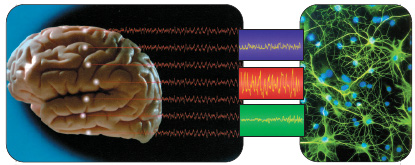 We live our entire life within our brain. The people that we see, the flowers we smell, the music we listen to, the fruits we taste, the wetness we feel on our hand… We know all of these in the form they appear in our brains. In reality, neither colors, nor sounds, nor images exist in our brain. The only things that exist in the brain are electric signals. This means that we live in a world formed by the electric signals in our brain. This is not an opinion or a hypothesis, but the scientific explanation of how we perceive the world.
| ||||||||||||||||||
In other words, all of our feelings and perceptions about the world (smells, visions, tastes etc.) are comprised of the same material, that is, electrical signals. Moreover, our brain is what makes these signals meaningful for us, and interprets these signals as senses of smell, taste, vision, sound or touch. It is a stunning fact that the brain, which is made of wet meat, can know which electrical signal should be interpreted as smell and which one as vision, and can convert the same material into different senses and feelings.
Let us now consider our sense organs, and how each one perceives the world.
Because of the indoctrination that we receive throughout our lives, we imagine that we see the whole world with our eyes. Eventually, we usually conclude that our eyes are the windows that open up to the world. However, science shows us that we do not see through our eyes. The millions of nerve cells inside the eyes are responsible for sending a message to the brain, as if down a cable, in order to make "seeing" happen. If we analyze the information we learned in high school, it becomes easier for us to understand the reality of vision.
 | 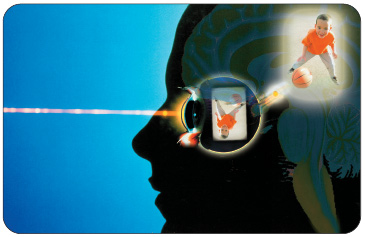 Everything We See and Own is Actually an Image That is Formed in Our Brains A person watching a small child playing with a ball is actually not seeing him with his or her eyes. Eyes are only responsible for delivering light to the back of the eyes. When light reaches the retina, an upside-down and two-dimensional view of the child is formed on the retina. Subsequently this view of the child is converted into an electric current, which is then transmitted to the visual center at the back of the brain, where the child's figure is seen perfectly in three dimensions. Who then sees the child's figure in three dimensions with perfect clarity at the back of the brain? Clearly, the entity we are dealing with is the Soul, which is a being beyond the brain. | ||
The light reflecting off an object passes through the lens of the eye and causes an upside-down image on the retina at the back of the eyeball. After some chemical operations carried out by retinal rods and cones, this vision becomes an electrical impulse. This impulse is then sent through connections in the nervous system to the back of the brain. The brain converts this flow into a meaningful, three-dimensional vision.
 All The Things We See and Own are Actually Images That Have Been Formed in Our Brains When a person rubs his eye, he sees the image of his car moving up and down. This is proof that the observer is seeing not the actual car itself, but its image in his brain. | ||
For example, when you watch children playing in a park, you are not seeing the children and the park with your eyes, because the image of this view forms not before your eyes, but at the back of your brain.
Even though we have given a simple explanation, in reality the physiology of vision is an extraordinary operation. Without fail, light is converted into electrical signals, and, subsequently, these electrical signals reveal a colorful, shining, three-dimensional world. R. L. Gregory, in his book Eye and Brain: The Psychology of Seeing, acknowledges this significant fact, and explains this incredible structure:
We are given tiny distorted upside-down images in the eyes, and we see separate solid objects in surrounding space. From the patterns of simulation on the retinas we perceive the world of objects, and this is nothing short of a miracle.2
All of these facts lead to the same conclusion. Throughout our lives, we always assume that the world exists outside of us. However, the world is within us. Although we believe that the world lies outside us, it is in the smallest part of our brain. For example, the CEO of a company might consider that he has direct contact with the external existence of the company building, his car in the parking lot, his house by the beach, his yacht, and all the people who work for him, his lawyers, his family, and his friends. However, he merely confronts images of all of these things formed in his skull, in a tiny part of his brain. He never knows the actual of the matter in the outside world.
He is unaware of this fact and, even if he knew, would not bother to think about it. If he stood proudly next to his latest-model luxury car, and the wind blew a piece of dust or a small object into his eye, he might gently scratch his itching, open eye and notice that the "material things" he saw moved upside down or to the sides. He might then realize that material things seen in the environment are not stable.
What this demonstrates is that every person throughout his or her life witnesses everything inside their brain and cannot reach the specific material objects that supposedly cause their experiences. The images we see are copies in our brains of the objects that exist outside of us. We can never know the originals of these copies.
Although German psychiatry professor Hoimar Von Ditfurth is a materialist, he acknowledges this fact about scientific reality:
No matter how we put the argument, the result doesn't change. What stands before us in full shape and what our eyes view is not the "world". It is only its image, a resemblance, a projection whose association with the original is open to discussion.3
For example, when you take a look at the room in which you are sitting, what you see is not the room outside of you, but a copy of the room that exists in your brain. You will never be able to see the original room with your sense organs.
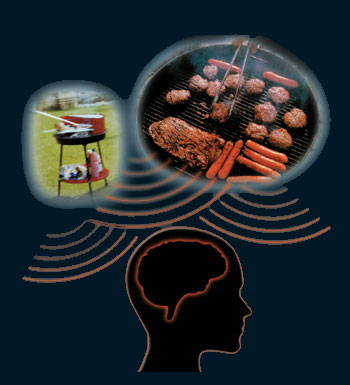 |
In the Darkness of Our Brains We See a Bright World | |||
There is another point that should not be neglected; light cannot pass through the skull. The physical area in which the brain is located is completely dark, and light cannot possibly penetrate it. However, incredible as it may seem, it is possible to observe a bright and colorful world in this total darkness. Colorful natural beauty, bright sights, all the tones of the color green, the colors of fruits, the designs of flowers, the brightness of the sun, people walking on a busy road, fast cars in traffic, clothes in a shopping mall—are all created in the dark brain.
Imagine a barbecue burning in front of you. You can sit and watch the fire for a long time, but throughout this entire time, your brain never deals with the original of light, brightness or heat from the fire. Even when you feel its heat and see its light, the inside of your brain remains dark and maintains a constant temperature. It is a profound mystery that, in the darkness, the electrical signals turn into colorful, bright visions. Anyone who thinks deeply will be amazed by this wondrous occurrence.
|
| ||||||||||||||||||||||||||||||
| While discussing what science has discovered about vision, we mentioned that the light we receive from the outside gives rise to some movements of the eye cells, and these movements form a pattern from which our visual experience emerges. However, there is another point that we need to make: Light, as we perceive it, does not reside outside of our brain. The light we know and understand is also formed within our brain. What we call light in the outside world, which is supposedly outside our brains, consists of electromagnetic waves and particles of energy called photons. When these electromagnetic waves or photons reach the retina, light, as we experience it, begins to come into existence. This is the way light is described in physical terms: The term "light" is used for electromagnetic waves and photons. The same term is used in physiology, as the feeling experienced by a person when electromagnetic waves and photons strike the retina of the eye. In both objective and subjective terms, "light" is a form of energy coming into existence in the eye of a person, which a person becomes aware of through the retina by the effects of vision.4 Consequently, light comes into existence as a result of the effects that some electromagnetic waves and particles cause in us. In other words, there is no light outside our bodies which creates the light we see in our brains. There is only energy. And when this energy reaches us we see a colorful, bright, and light-filled world. | |||||||||||||||||||||||||||||||
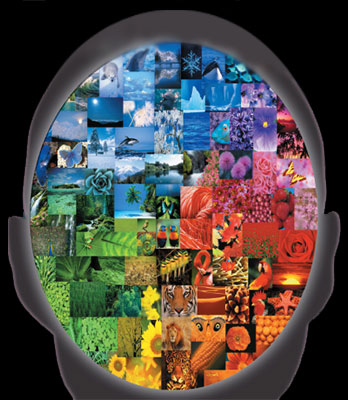 All Colors are Formed in Our Brains There are No Colors in The Outside World There are no colors in the world outside. Colors are only formed in the eyes and brain of the observer. Only energy packets of various wavelengths exist in the external world. It is our brains that transform this energy into colors. | ||
Starting from the time, we are born, we deal with a colorful environment and see a colorful world. However, there isn't one single color in the universe. Colors are formed in our brains. Outside there are only electromagnetic waves with different amplitudes and frequencies. What reaches our brains is the energy from those waves. We call this "light", although this is not the light we know as bright and shiny. It is merely energy. When our brains interpret this energy by measuring the different frequencies of waves, we see "colors". In reality, the sea is not blue, the grass is not green, the soil is not brown and fruits are not colorful. They appear as they do because of the way we perceive them in our brains. Daniel C. Dennett, who is known for his books about the brain and consciousness, summarizes this universally accepted fact:
The common wisdom is that modern science has removed the color from the physical world, replacing it with colorless electromagnetic radiation of various wavelengths.5
In The Amazing Brain, R. Ornstein and R. F. Thompson have stated the way colors are formed as follows.
'Color' as such does not exist in the world; it exists only in the eye and brain of the beholder. Objects reflect many different wavelengths of light, but these light waves themselves have no color.6
In order to understand why this is so, we must analyze how we see colors. The light from the sun reaches an object, and every object reflects the light in waves of different frequencies. This light of varying frequency reaches the eye. (Remember that the term "light" used here actually refers to the electromagnetic waves and photons, not the light which is formed in our brains.) The perception of color starts in the cone cells of the retina. In the retina, there are three groups of cone cells, each of which reacts to different frequencies of light. The first group is sensitive to red light, the second is sensitive to blue light, and the third is sensitive to green light. With the different levels of stimulations of these cone cells, millions of different colors are formed. However, the light reaching the cone cells cannot form colors by itself. As Jeremy Nathans of John Hopkins Medical University explains, the cells in the eye do not form the colors:

There is no light and no color outside of our brains. Colors and light are formed in our brains. In the retina in the eye, there exist three groups of cone cells, each of which react to different wavelengths of light. The first of these groups is sensitive to red light, the second is sensitive to blue light and the third is sensitive to green light. Different levels of stimulus to each of the three sets of cone cells gives rise to our ability to see a world full of color in millions of different tones. | 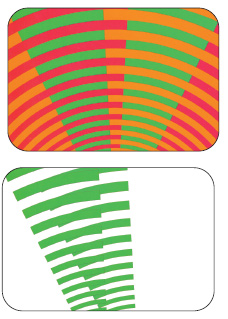 In the picture shown above right, the green area on the left hand side appears to be dark while the green area on the right hand side appears lighter. In fact, the tones of both greens, as shown in the bottom are exactly the same. The red and orange colors next to the green bands trick us into thinking that the two green colors are of different tones. This again points to the fact that we do not see the original material world, we only see our interpretation of it in our brain. | ||
| Because of God's perfect creation, we see electrical signals as a bright world, full of color, made up of millions of shades of color, and we enjoy what we see. This is an extraordinary miracle that must be carefully considered. | |||
All that a single cone can do is capture light and tell you something about its intensity. It tells you nothing about color.7
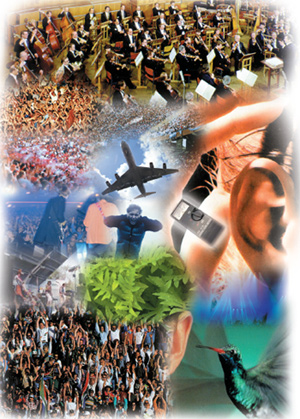 All Sounds are Formed in Our Brains There are No Sounds in The Outside World | ||
The cone cells translate the information they get about colors to electrical signals thanks to their pigments. The nerve cells connected with these cells transmit these electrical signals to a special area in the brain. The place where we see a world full of color throughout our lives is this special area in the brain.
This demonstrates that there are no colors or light beyond our brains. There is only energy which moves in the form of electromagnetic waves and particles. Both color and light exist in our brains. We do not actually see a red rose as red simply because it is red. Our brain's interpretation of the energy that reaches our eye leads us to perceive that the rose is red.
Color blindness is proof that colors are formed in our brains. A small injury in the retina can lead to color blindness. A person affected by color blindness is unable to differentiate between red and green colors. Whether an external object has colors or not is of no importance, because the reason why we see objects colorful is not their being colorful. This leads us to the conclusion that all of the qualities that we believe belong to the object are not in the outside world, but in our brains. However, since we will never be able to go beyond our perceptions and reach the outside world, we will never be able to know the originals of materials and colors. The famous philosopher, Berkeley, acknowledges this fact with the following words:
If the same things can be red and hot for some and the contrary for others, this means that we are under the influence of misconceptions ...8
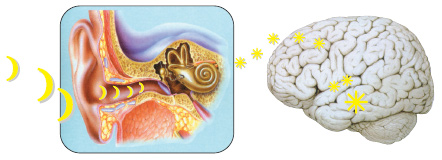 The outer ear captures sound waves and delivers them to the middle ear. The middle ear amplifies these sounds and transmits them to the inner ear. The inner ear converts these sounds into electric signals on the basis of their intensity and frequency and then sends them to the brain. | ||
The hearing process also operates in a similar manner to the visual process. In other words, we hear sounds in our brains in the same way that we see the view of the outside world in our brains. The ear captures the sounds around us and delivers them to the middle ear. The middle ear amplifies the sound vibrations and delivers them to the inner ear. The inner ear transforms these sound vibrations into electric signals, on the basis of their frequency and intensity, and then transmits them to the brain. These messages in the brain are then sent to the hearing center where the sounds are interpreted. Therefore, the hearing process takes place in the hearing center in essentially the same way that the seeing process takes place in the seeing center.
Therefore, actual sounds do not exist outside our brains, even though there are physical vibrations we call sound waves. These sound waves are not transformed into sounds outside or inside our ears, but rather inside our brains. As the visual process is not performed by our eyes, neither do our ears perform the hearing process. For example, when you are having a chat with a friend, you observe the sight of your friend in your brain, and hear his or her voice in your brain. As the view in your brain is formed, you will have a deep feeling of three dimensions, and your friend's voice is also heard with a similar feeling of depth. For example, you could see your friend as being a long way from you, or sitting behind you; accordingly you feel his voice as if it is coming from him, from near you or from your back. However, your friend's voice is not far away or behind you. It is in your brain.
The extraordinariness about the real nature of the sound you hear is not limited to this. The brain is actually both lightproof and soundproof. Sound never in fact reaches the brain. Therefore, despite the volume of the sounds you hear, the interior of your brain is actually very quiet. However, you hear noise, such as voices, very clearly in your brain. They are so clear that a healthy person hears them without difficulties or distortions. You hear the symphony of an orchestra in your soundproof brain; you can hear all the sounds in a wide range of frequencies and decibel from the sounds of the leaves to the sounds of jet planes. When you go to a concert of your favorite singer, the deep and loud noise that fills the whole stadium is formed in the deep silence of your brain. When you sing by yourself loudly you hear the sound in your brain. However, if you were able to record the sound in your brain with a tape recorder at that moment, you would hear only silence. This is an extraordinary fact. The electrical signals that reach the brain are heard in your brain as sound, for example the sound of a concert in a stadium filled with people.
Although People Presume That They See The Original of Matter Light, Sound And Colors Do Not Exist Outside of Our Brains; Only Energy ExistsAlthough the fact that everything we experience is a totality of perceptions formed inside our brains has been scientifically proven, some people still claim that they see the originals of these images that exist outside our brains. However, they will never be able to prove this claim. As mentioned before, light, sound or colors do not exist outside of our brains. Light only exists outside in the form of energy waves and packets of energy, and we only become aware of light when it hits the retina. Similarly, there is no sound. There are only energy waves. Sound only forms when these energy waves reach our ears and are subsequently transmitted to our brains. There is no color outside, either. When we say "there is no color" people might think of a view of black, white or gray. In fact, these are also colors. In the world outside of our brains even the colors of black, white and gray do not exist. Only energy waves in varying strength and frequency exist, and these energy waves are only converted into colors through the cells in the eye and the brain. Quantum physics is another branch of science which shows that the claims of those who say that they see the original of matter are unjustified. The most important truth discovered by quantum physics, which leaves materialists speechless, is that matter is 99.9999999% empty. In his studies of physics and psychology, Peter Russell often makes comments about human consciousness. In an essay adapted from his book, From Science To God, Russell explains this truth thusly: Take, for example, our ideas as to the nature of matter. For two thousand years it was believed that atoms were tiny balls of solid matter-a model clearly drawn from everyday experience. Then, as physicists discovered that atoms were composed of more elementary, subatomic, particles (electrons, protons, neutrons, and suchlike), the model shifted to one of a central nucleus surrounded by orbiting electrons-again a model based on experience. An atom may be small, a mere billionth of an inch across, but these subatomic particles are a hundred-thousand times smaller still. Imagine the nucleus of an atom magnified to the size of a grain of rice. The whole atom would then be the size of a football stadium, and the electrons would be other grains of rice flying round the stands. As the early twentieth-century British physicist Sir Arthur Eddington put it, "matter is mostly ghostly empty space"-99.9999999 percent empty space, to be a little more precise. With the advent of quantum theory, it was found that even these minute subatomic particles were themselves far from solid. In fact, they are not much like matter at all-at least nothing like matter as we know it. They can't be pinned down and measured precisely. They are more like fuzzy clouds of potential existence, with no definite location. Much of the time they seem more like waves than particles. (Peter Russell, The Mystery of Consciousness and the Meaning of Light, 12 Oct 2000, http://www.arlingtoninstitute.org/futureedition/From_Science-To-God.htm) We can thus see that science shows us that beyond the confines of our brain, there are only energy waves and energy packets. Beyond our brain there is no light, no sound and no color. Additionally, atoms and subatomic particles that form a material are actually loose groups of energy. As a result, material is comprised of space. In reality, God creates matter through a vision with these qualities.
| ||||
 If someone is asked how he senses the smells around him, he would probably say "with my nose". However, this answer is not the right one, even though some would instantly conclude that it was the truth. Gordon Shepherd, a professor of neurology from Yale University, explains why this is incorrect; "We think that we smell with our noses, [but] this is a little like saying that we hear with our ear lobes."9
If someone is asked how he senses the smells around him, he would probably say "with my nose". However, this answer is not the right one, even though some would instantly conclude that it was the truth. Gordon Shepherd, a professor of neurology from Yale University, explains why this is incorrect; "We think that we smell with our noses, [but] this is a little like saying that we hear with our ear lobes."9
 All Smells Take Place Within Our Brain A person smelling roses in his or her garden does not, in reality, smell the originals of the roses. What he or she senses is an interpretation of electrical signals by his or her brain. However, the smell seems so real that the person would never understand that he or she is not smelling the original rose, and some therefore suppose that they are smelling the real rose. This is a great miracle created by God. | ||
Our sense of smell works in a similar mechanism to our other sense organs. In fact, the only function of the nose is its ability to act as an intake channel for smell molecules. Volatile molecules such as vanilla, or the scent of a rose, come to receptors located on hairs in a part of the nose called the epithelium and interact with them. The result of the interaction of the smell molecules with the epithelium reaches the brain as an electric signal. These electric signals are then perceived as a scent by the brain. Thus, all smells which we interpret as good or bad are merely perceptions generated in the brain after the interaction with volatile molecules has been transduced into electric signals. The fragrance of perfume, of a flower, of a food which you like, of the sea—in short all smells you may or may not like—are perceived in the brain. However, the smell molecules never actually reach the brain. In our sense of smell, it is only electrical signals which reach the brain, as happens with sound and sight.
Consequently, a smell does not travel in any particular direction, because all smells are perceived by the smell center in the brain. For example, the smell of a cake does not come from the oven, in the same way that the smell of the dish does not come from the kitchen. Likewise, the smell of honeysuckle does not come from the garden and the smell of the sea, some distance away from you, does not come from the sea. All of these smells are sensed at one point, in a related area of the brain. There is no concept of right or left, front or back, outside of this sense center. Although each of the senses seem to occur with different effects, and may appear to be coming from different directions, they all in fact occur within the brain. The smells which occur in the smell center of the brain are assumed to be the smells of outside materials. However, the image of the rose is generated in the sight center and the smell of a rose is generated in the smell center. If there is a genuine smell outside, you can never reach the original of it.
George Berkeley, a philosopher who has realized the importance of this truth, says "At the beginning, it was believed that colors, odors, etc., 'really exist,' but subsequently such views were renounced, and it was seen that they only exist in dependence on our sensations."
It may be instructive to consider dreams in order to understand that smell is only a sensation. When people dream, in the same way that all images are seen very realistically, smells are also perceived as if they were real. For example, a person who goes to a restaurant in his dream may choose his dinner amid the smells of the foods that are on the menu; someone who dreams of going on a trip to the sea side senses the distinctive smell of the sea, and someone who dreams of a daisy garden would experience, in his dream, the pleasure of the magnificent scents. Likewise, someone who dreams of going to a perfume shop and choosing a perfume would be able to distinguish between the smells of the perfumes, one by one. Everything in the dream is so realistic that when the person wakes up, he or she might be surprised by this situation.
In fact, it is not necessary to examine dreams to understand the subject. It is even sufficient to imagine one of the depictions that were mentioned, such as the example of the daisy. If you concentrate on the daisy, you can feel as if you are aware of its scent, even though it isn't there. The scent is now occurring in the brain. If you want to visualize your mother in your mind, you can see her in your mind, even though she isn't there in front of you; in the same way you can imagine the smell of the lily, even though it isn't there.
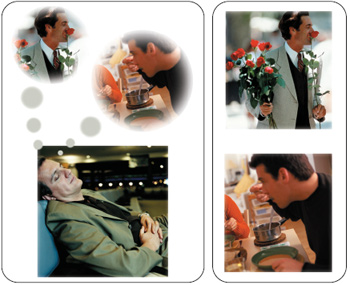 The purpose of the nose is to receive smell signals and transmit them to the brain. The smell of soup, or a rose, is sensed in the brain. However, a person can sense the smell of the rose or soup in his dream, even in the absence of any soup or roses. God forms such a convincing collection of senses within the brain with the taste, smell, vision, sense of touch and sound that it takes a lot of explanation to demonstrate to people that all of these feelings occur in the brain and that they are actually not dealing with the originals of anything they see. This is the magnificent knowledge of God. |  A person can picture the face of his wife or imagine the smell of a daisy in his brain with little concentration. The question then is that who is seeing without the need of an eye or smelling without the need of a nose things that physically do not exist nearby? This being is the soul of the person. | ||
Michael Posner, a psychologist and Marcus Raichle, a neurologist from Washington University comment on the issue of how sight and other senses occur, even in the absence of an external stimulus:
Open your eyes, and a scene fills your view effortlessly; close your eyes and think of that scene, and you can summon an image of it, certainly not as vivid, solid, or complete as a scene you see with your eyes, but still one that captures the scene's essential characteristics. In both cases, an image of the scene is formed in the mind. The image formed from actual visual experiences is called a "percept" to distinguish it from an imagined image. The percept is formed as the result of light hitting the retina and sending signals that are further processed in the brain. But how are we able to create an image when no light is hitting the retina to send such signals? 10
There is no need for an external source to form an image in your mind. This same situation holds true for the sense of smell. In the same way as you are aware of a smell which does not really exist in your dreams or imagination, you cannot know about those objects, which you smell in real life, that exist outside you. You can never deal with the original objects.
 |  | ||
| All Tastes Occur Within Our Brains | The Sense of Touch also Occurs Within Our Brains | ||
The sense of taste can be explained in a manner similar to those of the other sense organs. Tasting is caused by little buds in the tongue and throat. The tongue can detect four different tastes, bitter, sour, sweet and salty. Taste buds, after a chain of processes, transform sensory information into electrical signals and then transfer them to the brain. Subsequently, those signals are perceived by the brain as tastes. The taste that you experience when you eat a cake, yogurt, a lemon or a fruit is, in reality, a process that interprets electrical signals in the brain.
An image of a cake will be linked with the taste of the sugar, all of which occurs in the brain and everything sensed is related to the cake which you like so much. The taste that you are conscious of after you have eaten your cake, with a full appetite, is nothing other than an effect generated in your brain caused by electrical signals. You are only aware of what your brain interprets from the external stimuli. You can never reach the original object; for example you cannot see, smell or taste the actual chocolate itself. If the taste nerves in your brain were cut off, it would be impossible for the taste of anything you eat to reach your brain, and you would entirely lose your sense of taste. The fact that the tastes of which you are aware seem extraordinarily real should certainly not deceive you. This is the scientific explanation of the matter.
The sense of touch is one of the factors which prevents people from being convinced of the aforementioned truth that the senses of sight, hearing and taste occur within the brain. For example, if you told someone that he sees a book within his brain, he would, if he didn't think carefully, reply "I can't be seeing the book in my brain—look, I'm touching it with my hand". Or, if we said "we cannot know the original of this book that exists as a material object outside", again the same superficially minded person might answer "no, look, I'm holding it with my hand and I feel the hardness of it - so I know what it actually is like ".
However, there is a fact that such people cannot understand, or perhaps just ignore. The sense of touch also occurs in the brain as much as do all the other senses. That is to say, when you touch a material object, you sense whether it is hard, soft, wet, sticky or silky in the brain. The effects that come from your fingertips are transmitted to the brain as an electrical signal and these signals are perceived in the brain as the sense of touch. For instance, if you touch a rough surface, you can never know whether the surface is, in reality, indeed a rough surface, or how a rough surface actually feels. That is because you can never touch the original of a rough surface. The knowledge that you have about touching a surface is your brain's interpretation of certain stimuli.
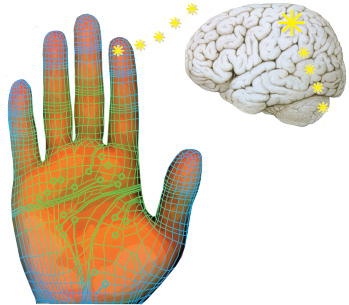 | 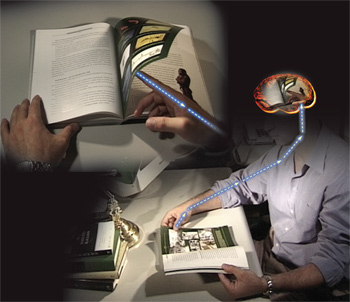 The fact that you are feeling the book you are reading now does not change the fact that you are seeing the book within your brain. As with the appearance of the book, the sense of touching the book also takes place in your brain. | ||
A person chatting to a close friend while drinking a cup of tea immediately lets go of the cup when he burns his hand on the hot cup. However, in reality, that person feels the heat of the cup in his mind, not in his hand. The same person visualizes the image of the cup of tea in his mind, and senses the smell and taste of it in his mind. However, this man does not realize that he actually has contact only with the copy of the tea within his brain. He assumes that he has direct contact with the original glass, and talks to his friend, whose image occurs again within his brain. In fact, this is an extraordinary case. The assumption that he is touching the original glass and drinking the original tea, which appears to be justified by his impression of the hardness and warmth of the cup and the taste and smell of the tea, shows the astonishing clarity and perfection of the senses which exist within one's brain. This important truth, which needs careful consideration, is expressed by twentieth century philosopher Bertrand Russell:
As to the sense of touch when we press the table with our fingers, that is an electric disturbance on the electrons and protons of our fingertips, produced, according to modern physics, by the proximity of the electrons and protons in the table. If the same disturbance in our finger-tips arose in any other way, we should have the sensations, in spite of there being no table.11
The point that Russell makes here is extremely important. In fact, if our fingertips are given a stimulus in a different manner, we can sense entirely different feelings. However, as it will be explained in detail in due course, today this can be done by mechanical simulators. With the help of a special glove, a person can feel the sensation of stroking a cat, shaking hands with someone, washing his hands, or touching a hard material, even though none of these things may be present. In reality, of course, none of these sensations represent occurrences in the real world. This is further evidence that all the sensations felt by a human being are formed within the mind.
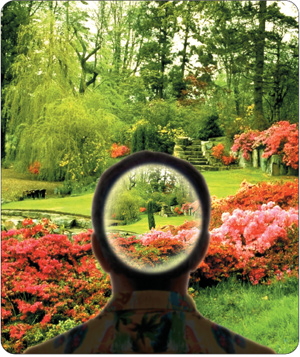 A person who is observing a particular view supposes that he is watching the view before his eyes. However, that view actually forms in the center of vision at the back of the brain. The pertinent question is this: who is that takes pleasure from watching this view, if it cannot be the brain, which is made of lipid and protein? | ||
As has been demonstrated here, everything that we live through, see, hear and feel in our life occurs within the brain. For example, someone who looks out of the window while sitting on an armchair feels the hardness of the armchair and the slipperiness of the fabric in his brain. The smell of the coffee coming from the kitchen occurs in the mind, not in the kitchen some distance away. The view of the sea, birds and trees he sees from the window are all images formed in the brain. The friend who is serving the coffee, and the taste of the coffee also exist in the brain. In short, someone sitting in his living room and looking out of the window is in reality looking at his living room, and the view seen from the window on a screen in his brain. What a human being would refer to as "my life" is a collection of all perceptions being put together in a meaningful way and watched from a screen in the brain, and one can never come out of one's brain.
We can never know the true nature of the original of the material world outside the brain. We cannot know, whether or not the original, for example the green of a leaf, is as we perceive it. Likewise, we can never find out if a dessert is really sweet or whether that is just how our brain perceives it to be. Imagine, for example, a landscape you have seen before. That landscape is not in front of you, but you are seeing it in your brain. The science writer Rita Carter says:
Whenever we recall a given object, face or scene, we do not get an exact reproduction but rather an interpretation, a newly reconstructed version of the original… Although they may appear to be good replicas, they are often inaccurate or incomplete.12
The same thing applies to the time when you look at a landscape. There is in fact no difference between your imagining a landscape from a distance and seeing it close up. Therefore, when you look at a view you are actually seeing a version constructed in the brain, not the original.
Anyone who considers this will clearly see the truth. One such person, George Berkeley, expresses this truth in his work A Treatise Concerning the Principles of Human Knowledge:
By sight I have the ideas of light and colours, with their several degrees and variations. By touch I perceive hard and soft, heat and cold, motion and resistance... Smelling furnishes me with odours; the palate with tastes; and hearing conveys sounds... And as several of these are observed to accompany each other, they come to be marked by one name, and so to be reputed as one thing. Thus, for example, a certain colour, taste, smell, figure and consistence having been observed to go together, are accounted one distinct thing, signified by the name apple; other collections of ideas constitute a stone, a tree, a book, and the like sensible things...13
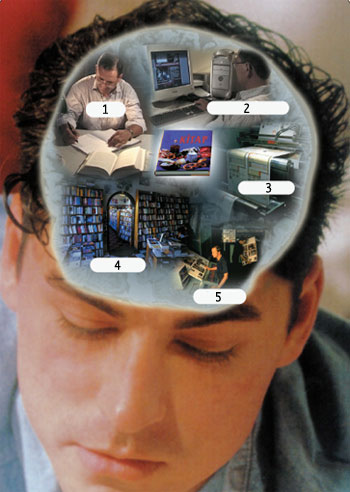 | You Can Never Get Out of The Room in Your Brain During Your Life Imagine that you are entering a dark room which has a big television screen inside. If you could only watch the outside world through this screen, you would naturally get bored of it after a while and want to get out. Consider for a moment that the place you are in is no different. Inside your dark little skull, similar to a box, you watch visions of the outside world during your life. You continue watching all of these pictures in your brain without getting out of this small place and never get tired of it. In addition to this, you would never believe that you were watching all of these things from a single screen. The vision is so convincing that in thousands of years, billions of people were unable to realize this great reality.
| |||||||
The truth Berkeley expresses in these words is this: We define an object by interpreting different sensations that are experienced in the brain. As is the case in this example, the taste and smell of an apple, its hardness and roundness and those sensations related with the other qualities of it are perceived as a whole by our brain and we perceive this whole as the apple. However, we can never actually deal with the original of the apple, only our perception of it. What we can see, smell, taste, touch or hear are only the copies within the brain.
When we consider all that has been discussed up to this point, the truth will be revealed in all clarity. For example:
- If we can see a street full of colorful lights and all the colors with their own brilliant shadings inside the brain where there is no actual light, then we are seeing copies of the notice boards, lights, streetlights and the headlamps of cars which are produced from the electric signals within the brain.
- Since no sound can enter the brain, we can never hear the original of the voices of loved ones. We hear only copies.
- We cannot feel the cool of the sea, the warmth of the sun – we only feel the copies of them in our brains.
- In the same way, nobody has been able to taste the original of mint. The taste someone would sense as mint is only a perception which occurs in the brain. This is because the person cannot touch the original of the mint, see the original of the mint or smell or taste the original of the mint.
In conclusion, throughout our lives we live with copy-perceptions which are shown to us. However, these copies are so realistic that we never realize that they are copies. For example, lift your head and have a look around the room. You see that you are in a room full of furniture. When you touch the arms of the armchair in which you are sitting, you feel the hardness of it as if you are really touching the original of it. The reality of these images shown to you, and the excellent artistry in the creation of these images are sufficient to convince you and billions of other people that the images are "the original of the external matter". Even though most people have read that every sensation relating to the world is formed in their brains, since it is taught in high school biology classes, the images are so convincing that they have difficulty believing that they are actually dealing with only copies in their brain. The reason for this is that each image is created very realistically and perfected to an art.
Nobody has been able to move out of the perceptions that exist in the brain. Everybody lives in the cell that is in the brain, and no one can experience anything except that which is shown by his perceptions. Consequently, one can never know what happens outside of his perceptions. Thus to say "I know the original of matter" would in fact be an unjustified presupposition, because there is nothing that could be held up as evidence. The observer deals with the images formed in his or her brain. For instance, a person who wanders in a garden full of colorful flowers can in fact never see the actual of the garden, but its copy in his brain. Yet, this garden is so realistic that every person gets the same delight from the garden formed in his brain as if it's the actual one. Even so that billions of people have surmised seeing the original of all they have seen just like that garden.
We should also emphasize that scientific or technological development cannot change anything, as every scientific discovery or technological invention occurs in the minds of people, and consequently is of no help to people in reaching the outside world.
Imagine a crowd on a street, with shops, buildings, cars, horns honking… When you look at this picture it appears to be real. That is why most people cannot understand that the picture they see is produced in their brain, and mistakenly suppose that they see the original of all of it. The picture has been created so perfectly that it is impossible to understand that the image that they perceive as real is not the original of the outside world, but only a copied image which exists in the mind.
The elements which make a picture so convincing and impressive are distance, depth, color, shade and light. These materials are used with such perfection that they become a three-dimensional, colorful and vivid image inside the brain. When an infinite amount of detail is added to the picture a whole new world emerges that, without realization, we assume is real for all life, although we only interpret it in our mind.
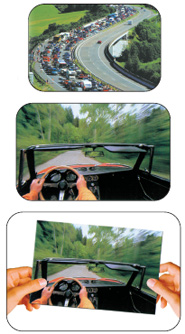 A person driving a car believes that the road and the trees he is driving past are far away from him. However, everything he sees is actually on a single plane in his brain just as in a photograph. |  In this picture, the line in the back appears twice the size of the line at the front. However, in reality both of the lines are the same size. As we can see from this example, the use of lines, perspective, the light and shadow cause people to observe the same objects differently. In fact, all of these objects are viewed in a single place, in the visual center of the brain. | ||
Imagine now that you are driving a car. The steering wheel is at arms length from you and there is a set of traffic lights about 100 m (or 300 ft) in front of you. The car in front of you is about 10 m (30 ft) away, while there are mountains on the horizon, which, according to your estimation, would be many kilometers (miles) away in the distance. However, all of these estimations are wrong. Neither the car nor the mountains are as far away as you would assume. In fact, the entire picture, as on a movie reel, exists on a two dimensional frame, on only one surface within the brain. The images reflected to the eye are two-dimensional, like those on a TV screen. In such circumstances, how can a perception of depth and distance occur?
 All The Objects You Perceive To Be Far Away From You are in Fact in Your Brain | ||
What is referred to as a sense of distance is a way of seeing three-dimensionally. The elements causing the effects of distance and depth in images are perspective, shade and motion. The form of perception called spatial perception by optical science is provided by highly complicated systems. This system can be explained simply in this way: The sight which reaches the eye is two dimensional. That is to say, it has measures of height and width. The senses of depth and distance result from the fact that two eyes see two different images at the same time. The image that reaches each of our eyes differs from the other in terms of the angle and light. The brain assembles these two different images to form our sense of depth and distance.
We can perform an experiment to understand this better. First, extend your right arm in front of you and hold up your index finger. Now focus on this finger while closing your left eye first and then your right eye. Because two different visions come to each eye, you will see the finger move slightly to one side. Now open both of your eyes and while continuing to focus on your right index finger, move your left index finger as close to your eye as you can. You will notice that the closest finger will have created two images. This is because now a different depth has formed in the closer finger from that in the farther finger. If you open and close your eyes one by one, you will see that the finger located nearer your eye will appear to move more than the finger which is further away. This is due to the increasing difference in the views appearing in each eye.
While a three dimensional film is being made, this technique is used; Images shot from two different angles are placed on the same screen. The audience wears special glasses which have a color filter and polarize the light. The filters in the glasses filter out one of the two views, and the brain transforms these into one single three-dimensional image.
The perception of depth in a retina with two dimensions is very similar to the technique used by artists to give the observer a feeling of depth in a picture with two dimensions. There are certain factors resulting in the feeling of depth, such as the placement of objects on top of one another, the atmosphere perspective, changes in texture, linear perspective, the dimensions, the height and the movement. For example the change of texture is very important in perceiving depth. For example, the ground that we walk on in a farm full of flowers is actually a tissue. The tissues closer to us are more detailed while the tissues further from us seem pale and harder to discern. Therefore, it is easier to estimate the distance of objects located on a tissue. Besides this, effects of shadow and light also contribute to the perception of a three-dimensional view.
The reason we admire a picture made by a successful artist is the sense of depth and reality which are given to the picture, which is created by using the elements of shade and perspective.
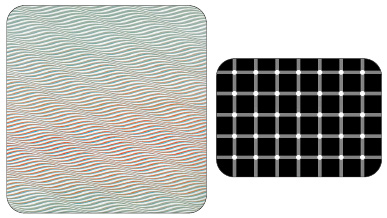 One of the significant elements which provides the feeling of depth is tissue differentiation. Tissues closer to us can be observed in detail while those further away appear less clearly. For example as we can observe from the picture on the side, a three dimensional tissue has been created on a paper with the feeling of depth, and which seems to be embossed due to the use of color, shadow and light. Even though all the dots are white in the above picture, they appear to be flashing in both black and white. | ||
Perspective results from the fact that distant objects appear smaller in proportion to those which are nearer, depending on the person who is looking at it. For example, when we look at a view, distant trees appear small, while those nearby appear large. Likewise, in a picture with a mountain in the background, the mountain is drawn smaller than the person in the foreground. In linear perspective, artists use parallel lines. For example, train tracks produce an effect of distance and depth by meeting with the horizon.
The method that painters use in their paintings is also valid for the image that occurs in the brain. Depth, light and shade are produced by the same method in two dimensional space in the brain. The greater the amount of detail in the picture, the more realistic it appears and the more it deceives our senses. We behave as if there was real depth and distance, as if there was a third dimension. However, all pictures are like a film square on a flat surface. The visual cortex in the brain is extremely small! The distances, the images such as those of distant houses, stars in the sky, the moon, the sun, airplanes flying in the air, and birds - they are all crammed into this small space. That is to say, there is technically no distance between a glass that you can hold by extending your hand and an airplane that, if you looked up, you would understand to be thousands of kilometers above; all of them are on the single surface, that is, in the sense center of the brain.
For example, a disappearing ship on the horizon is not actually miles away from you. The ship is in your brain. The window sill that you are looking at, a poplar tree in front of the window, the road in front of your house, the sea and the ship on the sea are all in the sight center of the brain, on a two dimensional surface. Just like a painter can represent the feeling of distance on a two dimensional canvas by using the proportions of size, elements of color, shade and light and perspective, so can the sense of distance also occur in the brain. In conclusion, the fact that we sense objects to be far away or nearby should not fool us, as distance is a sensation like all the others.
 | Creating a Picture With Depth on a Two Dimensional Surface There is a very realistic depth in all of these pictures. A three-dimensional view with depth can be formed on a two-dimensional canvas by making use of shade, perspective and light. This element of realism can be increased depending on the ability of the painter. The same can be said for our own sight perception as well, as the vision that reaches the retina in fact exists in two dimensions. However, the images reaching each of our eyes become a single image, so that our brain perceives a three-dimensional image with depth. | ||
One of the reasons that prevent people from understanding that the images seen are actually sensed in the brain, is that people see their body in the image. They come to this wrong conclusion that "since I am in this room, the room does not occur in my brain." Their mistake is to forget that they have direct contact with only an image of their body too. Just like everything we see around us merely consists of copy images, so does our body also exist as a copy image in the brain. For example, while sitting on an armchair, you can see the rest of your body below your neck. This image too is produced by the same perceptual system. When you put your hand on your leg, you sense a kinesthetic feeling in the brain. This means that you see your body in the brain, and you feel yourself touching your body in the brain.
If the body is an image in the brain, is the room inside of you or are you in the room? The obvious answer to this is "the room is inside of you". And you see the image of your body inside the room, which in turn is in the brain.
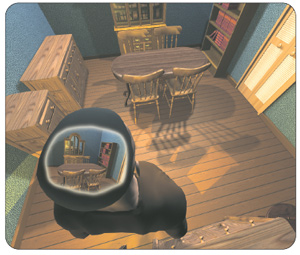
Since your body is an image seen in your brain, the question is this: are you inside the room that you are in, or is the room inside you? The answer is clear: of course, the room is inside you, in the vision center of your brain. | 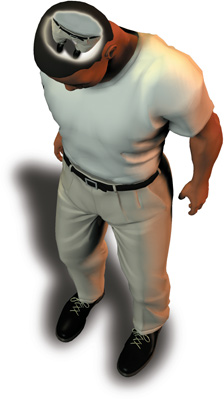 | ||
Let us explain this with an example. Let us suppose that you call a lift. When it comes, your neighbor, who lives upstairs from you, is in it. You get into the lift. In reality, are you in the lift or is it in you? The truth is: the lift with the images of the neighbor and your body all occurs in your brain.
In conclusion, we are not "inside" anything. Everything is inside us; everything occurs in the brain. The sun, the moon, stars or an airplane flying in the sky many miles away cannot change this truth. The sun and the moon, like the book that you hold are only copy images which occur in a very small sight center in the brain.
|
| In an experiment, blind people were made to see some visions by a device. Through the device, these blind people could see some very realistic visions not belonging to the outside world but produced artificially. They were under the impression that something was coming towards them, so they stepped back to protect themselves. | ||
Science writer, Rita Carter, states in her book, Mapping The Mind, that "there's no need for eyes to see" and describes at length an experiment carried out by scientists. In the experiment, blind patients were fitted with a device that transformed video pictures into vibrating pulses. A camera mounted next to the subjects' eyes spread the pulses over their backs so they had continuous sensory input from the visual world. The patients started to behave as if they could really see, after a while. For example, there was a zoom lens in one of the devices so as to move closer the image. When the zoom is operated without informing the patient beforehand, the patient had an urge to protect himself with two arms because the image on the subject's back expanded suddenly as though the world was looming in.14 As it is seen from this experiment, artificially produced senses can be enough to form sensations.
A person lies on his bed with closed eyes while dreaming. However, in spite of this, that person senses many things which he or she experiences in real life, and experiences them so realistically that the dreams are indistinguishable from the real life experience. Everyone who reads this book will often bear witness to this truth in their own dreams. For example, a person lying down alone on a bed in a calm and quiet atmosphere at night might, in his dream, see himself in danger in a very crowded place. He could experience the event as if it were real, fleeing from danger in desperation and hiding behind a wall. Moreover, the images in his dreams are so realistic that he feels fear and panic as if he really was in danger. He has his heart in his mouth with every noise, is shaken with fear, his heart beats fast, he sweats and demonstrates the other physical affects that the human body undergoes in a dangerous situation. However, there is no external equivalent of the events in his dream. They exist only in his mind.
|
When a person has a dream of being in a garden on a bitingly cold morning in the winter, he can feel the cold and start shaking. However, there is neither wind nor cold in his particular location. He might be even sleeping in a very warm room. Nevertheless, he feels the cold in all its reality. There is no difference between the cold he feels in the real world and the cold he is feeling in his dream. |
| A person sleeping in a comfortable bed in his home may dream that he is in the middle of a war. And he might also feel the fear, tension and the panic of the war as if it were taking place in the real world. Yet at that time he is sleeping in a comfortable bed by himself. The realistic noises and visions he sees in his dream occur in his mind. | ||
A person who falls from a high place in his dream feels it with all his body, even though he is lying in bed without moving. Alternatively, one might see oneself slipping into a puddle, getting soaked and feeling cold because of a cold wind. However, in such a case, there is neither a puddle, nor is there wind. Furthermore, despite sleeping in a very hot room, one experiences the wetness and the cold, as if one were awake.
|
A person sleeping in his house can see himself on a rapidly turning wagon in a fair ground while dreaming. He can realistically sense the wind that he would experience on a fast moving wagon in the real world. | ||
Someone who believes he is dealing with the original of the material world in his dream can be very sure of himself. He can put his hand on his friend's shoulder when the friend tells him that "he is dealing with a copy image of matter; it isn't possible to deal with the original of the world", and then ask "Am I an image now? Don't you feel my hand on your shoulder? If so, how can you be a copy image? What makes you think in this way? Let's take a trip up the Bosphorus; we can have a chat about it and you'll explain to me why you believe this." The dream that he sees in his deep sleep is so clear that he turns on the engine with pleasure and accelerates slowly, almost jumping the car by pressing the pedal suddenly. While going on the road, trees and road lines seem solid because of the speed. In addition, he breathes clean Bosphorus air. But suppose he is woken up by his ringing alarm clock just when he's getting ready to tell his friend that what he's living at that moment isn't a dream. Wouldn't he object in the same manner regardless of whether he was asleep or awake?.
When people wake up they understand that what they've seen until that moment is a dream. But for some reason they are not suspicious that the life that starts with a "waking" image (what they call "real life") can also be a dream. However, the way we perceive images in "real life" is exactly the same as the way we perceive our dreams. We see both of them in the mind. We cannot understand they are images until we are woken up. Only then do we say "what I have just seen was a dream". So, how can we prove that what we see at any given moment is not a dream? We could be assuming that the moment in which we are living is real just because we haven't yet woken up. It is possible that we will discover this fact when we are woken up from this "waking dream" which takes longer than dreams we see everyday. We do not have any evidence that proves otherwise
Many Islamic scholars have also proclaimed that the life around us is only a dream, and that only when we are awakened from that dream with "a big awakening", will people be able to understand that they live in a dreamlike world. A great Islamic scholar, Muhyiddin Ibn al-'Arabi, referred to as Sheikh Akbar (The greatest Sheikh) due to his superior knowledge, likens the world to our dreams by quoting a saying of the Prophet Muhammad (may God bless him and grant him peace):
The Prophet Muhammad [may God bless him and grant him peace] said that "people are asleep and wake up when they die." This is to say that the objects seen in the world when alive are similar to those seen when asleep while dreaming, meaning that they exist in the imagination.15
In a verse of Koran, people are told to say on doomsday when they are resurrected from the dead:
They will say, "Alas for us! Who has raised us from our sleeping-place? This is what the All-Merciful promised us. The Messengers were telling the truth." (Surah Ya Sin: 52)
As the verse demonstrates, people wake up on doomsday as if waking from a dream. Like someone woken from the middle of a dream in deep sleep, such people will similarly ask who has woken them up. As the verse points out, the world around us is like a dream and everybody will be woken up from this dream, and will begin to see images of the afterlife, which is the real life.
You Might Be Observing Your Life From Somewhere Else Just As You Observe Your DreamsA person drinking coffee in his dream can feel the exact taste of the sugar, the milk and the coffee, when there is no coffee or any other drink there. If someone were to come up to him and tell him that he is just dreaming, and that there is no coffee, then the person would reject such an idea. He might ask how it could be just a vision when he felt the heat of the coffee on his tongue, and when after drinking the coffee he no longer felt thirsty. He would ask how it could remove his thirst if it wasn't real? However, he understands only after he wakes up that the coffee, which he thinks he drank, was an image formed in his brain, and that sensations such as warmth and thirst, which he felt while drinking the coffee. were perceptions formed in his brain. Our experiences in our dreams and in the real world are based on the same logic. We experience both dreams and the real world in our mind. The only reason we believe that our dreams are imaginary is that when we wake up, we find ourselves in our bed, so we believe that we were actually sleeping and saw everything in our dreams. What would happen if we didn't wake up and continued dreaming? Would we be able to realize that we were not actually dealing with the originals of any of the things we lived and saw in our dream? Of course not. Unless we wake up and discover that we have been sleeping, we can never realize that we have been dreaming, and spend our entire life by supposing that this is our real life. So, how can we prove that our real life is not a dream? Do we have any information about what happens when we depart this life and find ourselves watching the pictures of our present life from a different location? | |||
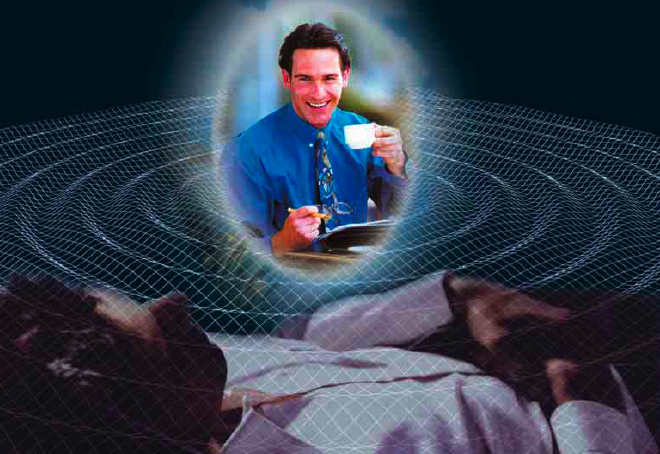 | |||
Modern technology presents many important examples of how sensory experience can be simulated with a high degree of realism, without the help of any external world. In particular, the technology called "virtual reality", which has developed considerably in recent years, gives us some insight on the subject.
Simply put, virtual reality involves showing animated three-dimensional images generated on a computer so as to construct "a real world" with the help of some equipment. This technology, which is used in many different fields for different aims, is called "artificial reality" or "virtual world" or a "virtual atmosphere". The most important characteristic of virtual reality is that a person who uses a special device believes that what he sees is real, and moreover he is captivated by that image. For that reason, recently, the word "immersive" is also used to describe virtual reality, with "immersive" meaning to involve deeply. (i.e. Immersive Virtual Reality)
The tools used to create a virtual world are a helmet (which houses a screen that provides an image) and a pair of electronic gloves (which provide a feeling of touch). A device in the helmet checks the movements and angle of the head in order to provide an image on the screen which is consistent with the head's angle and position. Sometimes, stereo pictures are reflected on the walls and floor of a room-size cell. People who wander through the room can see themselves through stereo glasses in different places, such as at the side of a waterfall, on the summit of a mountain, or sunbathing on the deck of a ship in the middle of the sea. The helmets create 3D pictures with a realistic sense of depth and space. The pictures are provided in proportion to human sizes and the sense of touch is provided by other equipment, such as gloves. Thus, a person who uses this equipment can touch the objects that he sees in the virtual world and can pick them up and move them. The sounds one hears in such places are also convincing, coming from any direction with different depths and volumes. In some applications, the very same virtual atmosphere can be presented to a few people in very different places in the world. Three people from different countries (even different continents) can see themselves with the others getting on board a powerboat.
The system used in the devices that create the virtual world is essentially the same as the system used in our five senses. For example, with the effect of a mechanism inside a glove worn by the user, some signals are given to the fingertips and then transmitted to the brain. When the brain processes these signals, the user has the impression of touching a silk carpet or a vase with a serrated surface, with puffy prints on it, even though there is no silk carpet or vase around.
One of the important fields in which virtual reality is now being used is medicine. With a technique developed in Michigan University, doctoral candidates (in particular emergency service staff) complete a part of their training in an artificial operating room. In this application, images related to an operating room are reflected onto the floors and walls of a room and the images of an operating table and a patient are reflected in the middle of the room. By putting on 3D glasses, doctoral candidates start to operate on this virtual patient.
These examples illustrate that a person can be placed in a realistic yet unreal world with the help of artificial stimuli. With current technology, an image can be produced which is an effective practice aide. There is no reason in principle that eventually this technology couldn't produce a reality which is indistinguishable from the real world. It is very interesting that some famous films made recently deal with the subject. For instance, in a Hollywood film called "Matrix", when the nervous system of two heroes of the film are connected to a computer while lying on a sofa, they can see themselves in completely different places. In one scene, they find themselves participating in eastern sports; in another, they are in completely different clothes walking in a very crowded street. When the hero, under the influence of his realistic experience, says that he does not believe that the pictures are created by a computer, the picture is frozen by the computer. The person then becomes convinced that the world which he believed to be real is indeed only an image.
In conclusion, it is possible in principle to create artificial images or, in other words, an artificial world with the help of artificial stimuli. So, we cannot claim that what we deal with in the "life image" that we are seeing all the time is necessarily "the original". Our senses could well be coming from a very different source.
One of the best examples of a world created with artificial stimuli is the technique of hypnosis. When a person is hypnotized, he experiences extremely convincing events which are indistinguishable from reality. The person under hypnosis sees pictures, people and various images, and hears, smells and tastes many things, none of which exist in the room. Meanwhile, because of the experience, he becomes happy, upset, excited, bored, worried or flustered. Moreover, the effect of the experience on the person under hypnosis can be watched from outside physically. In very deep hypnotic trances, certain kinds of symptoms can be observed in the hypnotized person, such as an increase in the pulse rate and blood pressure, redness of the skin, high temperature, and the removal of an existing pain or ache.16
In one hypnotic experiment, a hypnotic subject is told that he is in a hospital and that there is a dying patient on the tenth floor of the hospital. He has been hypnotized into believing that if he rushes to the patient with the right medicine, the patient will be rescued. The subject, under the influence of hypnosis, thinks he is rushing to the tenth floor. Meanwhile he gets out of breath and can't control it, due to a feeling of being extremely tired. Then the subject is told that he is on the top floor, and succeeded in fetching the medicine, and that he can lie on a comfortable bed. The subject then starts to relax.17
Although the subject experiences the locations and the atmospheres as if they were completely real, the places, people or events as told to him do not exist.
In another experiment, a hypnotic subject in a normal room is told that he is in a Turkish bath and that the bath is very hot. As a result, he starts to sweat.18
This draws our attention to a very important point. In order for a person to sweat, some conditions must exist. The reality that we come across in this instance of hypnosis is that the hypnotized person has sweated, even though there is no physical factor which would cause him to sweat. This example shows clearly that there is no physical necessity of direct experience of the original of places or atmosphere to feel such an atmosphere or place. Similar effects can be created through artificial stimulants or hypnotic suggestion.
The British hypnotherapy specialist, Terence Watts, a member of many organizations including The National Hypnotherapy Association, The National Psychotherapists Association, The Professional Hypnotherapists Center, The Hypnotherapy Research Association, states in an article that during hypnosis, some people who are recollecting a past event exhibit some physical changes related to the event. For example, if there was an element of suffocation in the event remembered, a hypnotic subject might become breathless while explaining the event under hypnosis and might even stop breathing for a while. Watts stated that under hypnosis, even finger marks appeared on one of his patients where a slap on the face was recalled. Watts also explains that this is not a mystery but a reaction to sense of pain in the body.19
One of the most striking examples seen in hypnotic applications is that even a wound can appear on the skin of the hypnotized person through inculcation. For example, Paul Thorsen, a researcher, touches the arm of the person under hypnosis with a tip of a pen and tells him that it's a hot skewer. Soon, a blister (as would have been produced by a second degree burn) formed in the region where the tip of the pen touched. Thorsen also hypnotized a person called Anne O. into believing that the letter A was being drawn onto her arm by pressing hard. Although nothing else was done, redness emerged in the shape of an "A" in that area.20 Researchers H. Bourru and P. Burot, persuading a hypnotized person that his arm was being cut, saw that the arm was bleeding after being slightly drawn on by a pencil.21
J.A. Hadfield told a sailor in hypnosis that he was going to press a hot iron bar on the sailor's arm and that the arm would burn. However, he merely touched it gently with his fingertip, after which he covered it. Six hours later when the cover was removed, there was a slight redness and puffiness in that area. Hadfield states that "the following day the puffiness became larger and swelled like a burn."22
These changes that occurred to the human body during hypnosis show that we do not need the outside world to produce sensations of sight, sound, touch, feeling, pain or ache. For example, although there is no hot iron bar in the outside world, if the person is persuaded, there can be a burn mark on his arm.
These examples show that when we examine how an image occurs, and follow technological developments, and also when we add consciousness-altering methods such as hypnosis to this knowledge, a certain truth becomes clear. Throughout his life, a human being assumes that he is living in a world which is external to his body. However, everything referred to as the world is only our brain's interpretation of the signals which reach the sense centers. In other words, we can never deal with any world other than the one that occurs in our mind. We can never know what happens or exists outside us. We cannot know what the original of the sources of signals reaching the brain is either. This reality has begun to take its place in science books and is taught to people since high school age. The problem is that people do not consider the full significance of this fact.
So far we have established that everything we perceive takes place in our brains. At this point we face a question which would be asked by anyone who thinks on this subject a little bit.
As we know, the electric signals coming from the cells in our eyes are transformed into an image in our brains. For example, the brain interprets some electrical signals coming to the visual center in the brain as a field filled with sunflowers. In reality, it is not the eye that is seeing.
Therefore, if it is not our eyes which are seeing, what is it that sees the electrical signals as a sunflower field, at the back of our brain, in a pitch dark place, without feeling any necessity for any eyes, retina, lens, visual nerves or pupil and enjoys the view in the sight?
Or who is it that hears (without needing an ear) the voice of a very close friend, becomes happy on hearing it, and misses it when he cannot hear it, when the brain is totally sound proof?
Or who is it in the brain that feels the fur of the cat when stroking it, without having any need for a hand, fingers or muscles?
Who is it that feels sensations such as heat, cold, and a sense of consistency, depth, and distance, as they originate in the brain?
Who is it that smells the lemon, lavender flower, rose, melon, watermelon, orange, and barbecued meat inside the brain (even though the brain is smellproof), and feels hungry because of the smell coming from the grill?
We have thus far discussed how everything we perceive continuously is actually formed inside our brains. Who is it then that sees the sights in a brain as if watching television, and becomes excited, happy, sad, nervous, or feels pleasure, anxiety or curiosity while watching them? Who is responsible for the consciousness which is capable of interpreting everything seen and everything felt?
What is the entity in the brain that has consciousness and throughout life is capable of seeing all the sights shown to him in a dark, quiet head, that is capable of thinking, and reaches conclusions and makes decisions in the end?
It is obvious that it is not the brain, made up of water, lipid and protein, and unconscious atoms, that perceives all this and is responsible for consciousness. There must be a being beyond the brain. Despite being a materialist, Daniel Dennett ponders the above question in one of his books:
My conscious thinking, and especially the enjoyment I felt in the combination of sunny light, sunny Vivaldi violins, rippling branches – plus the pleasure I took in just thinking about it all – how could all that be just something physical happening in my brain? How could any combination of electrochemical happenings in my brain somehow add up to the delightful way those hundreds of twigs genuflected in time with the music? How could some information-processing event in my brain be the delicate warmth of the sunlight I felt falling on me? For that matter, how could an event in my brain be my sketchily visualized mental image of … some other information-processing event in my brain? It does seem impossible. It does seem as if the happenings that are my conscious thoughts and experiences cannot be brain happenings, but must be something else, something caused or produced by brain happenings, no doubt, but something in addition, made of different stuff, located in a different space. Well, why not?23
On the other hand, R. L. Gregory questions the existence of the entity in the back of the brain, which sees all sights:
There is a temptation, which must be avoided, to say that the eyes produce pictures in the brain. A picture in the brain suggests the need of some kind of internal eye to see it – but this would need a further eye to see its picture… and so on, in an endless regress of eyes and pictures. This is absurd.24
Materialists who believe that nothing exists except matter cannot understand this particular question. Who does this "internal eye", which sees and perceives things seen and reacts to such things, belong to?
In the following passage, Karl Pribram describes this important search by science and philosophy for the identity of the perceiver:
Philosophers since the Greeks have speculated about the "ghost" in the machine, the "little man inside the little man" and so on. Where is the I—the entity that uses the brain? Who does the actual knowing? Or, as Saint Francis of Assisi once put it, "What we are looking for is what is looking".25
Although many people venture close to this reality in answering the question "who is the entity that sees", they hesitate to accept all of its implications. As demonstrated in the examples above, in discussing the entity in our brains, some refer to the "little man", while others say "the ghost in the machine", some refer to "the being using the brain" while some say "the internal eye". All these terms have been used to describe the entity beyond the brain which possesses consciousness, and the means of reaching this entity. However, materialist assumptions keep many people from understanding the true nature of this being which actually sees and hears.
The only source that answers this question is religion. In the Koran, God states that He created man in a physical way initially and then "breathed His Spirit" to the man He created:
When your Lord said to the angels, "I am creating a human being out of dried clay formed from fetid black mud when I have formed him and breathed My Spirit into him, fall down in prostration in front of him!" (Surat al-Hijr: 28-29)
(He) then formed him and breathed His Spirit into him and gave you hearing, sight and hearts. What little thanks you show! (Surat as-Sajda: 9)
In other words, the human being has another existence besides its physical body. That entity inside the brain which says "I am seeing" the sight inside the brain, and "I am hearing" the sound inside the brain and aware of its own existence, and which says "I am me", is the soul given to human beings by God.
Any human being with a mind and a conscience can understand this: the being that watches every incident inside the brain—watches as if looking at a screen throughout his life—is his soul. Every human being has a soul that sees without the need for an eye, hears without the need for an ear and thinks without the need for a brain.
The materialistic view—which maintains that matter is the only thing that exists, and that human consciousness is only a result of some chemical reactions in the brain—is in a quandary about this issue. To see this it might be instructive to ask the following questions to a materialist:
- Sight is formed in our brains but what is it that watches this sight in our brains?
- Try to see in your mind's eye your neighbor living downstairs in your apartment building when he is not with you. Who is it that vivifies this person so clearly in your imagination down to the details of his costume, the lines in his face, the whites in his hairs; the tone of his voice, the way he speaks, the way he walks?
A materialist will be unable to give a satisfactory answer to such questions. The only explanation to these questions is the soul given to man by God. However, materialists make a mistake not accepting the existence of any being other than matter. For this reason the truth explained in this book deals a massive blow to atheist materialist thought, and constitutes a subject that materialists refuse to discuss most.
At this level there is another question that should be asked: Our soul watches the sights in our brains. But who is it that creates these sights? Could the brain itself form a bright, colorful, clear, shadowy sight and form a whole world through electrical signals in a tiny space? The brain is no more than a wet, soft, curvy piece of meat. Could a simple piece of meat like this create a sight clearer than any that could be provided by a television set with the latest technology, without any snow or horizontal jitter? Could a vision of such high quality be formed inside a piece of meat? Could this wet piece of meat form a stereo sound of higher quality than a stereo hi-fi system with the highest technology, without any sizzling noises? of course, it is impossible for a brain, which is made of one and a half kilograms (four pounds) of meat to form such perfect perceptions.
Here we arrive at another truth. Since together with everything surrounding us, the body we have, our hands, arms and faces are the shadow beings, then our brains are also shadow beings. Thus we cannot say that this brain which is itself actually only a visual sensation, forms these visual sensations.
Bertrand Russell points out this truth in his work The ABC of Relativity: of course, if matter in general is to be interpreted as a group of occurrences, this must apply also to the eye, the optic nerve and the brain.26
Realizing this fact, French philosopher Bergson said in his book, Matter and Memory, that "the world is made up of images, these images only exist in our consciousness; and the brain is one of these images."27
Who, then, is the being that shows these sights to our souls, with all their reality and clarity, and lets us live a life with all of these perceptions and without any interruptions?
The being that shows all the sights to our souls, lets us hear all the sounds, and creates all the tastes and smells for our pleasure, is the Lord of all the worlds, the creator of everything, God.
Materialist philosophy can never explain the source of human consciousness, i.e. the qualitative experiences that belong to the human soul. For the materialist philosophy, matter is the only thing that exists. Qualities belonging to the soul of a human being, such as consciousness, thought, decision-making processes, happiness, excitement, longing, enjoyment and judgment can never be explained in the materialistic concept. Materialists pass quickly over this subject saying "human consciousness is only the result of the functions of the brain". A materialist scientist, Francis Crick summarizes this materialistic claim as follows:
Your joys and your sorrows, your memories and your ambitions, your sense of personal identity and free will, are in fact no more than the behaviour of a vast assembly of nerve cells and their associated molecules.28
However, such a claim cannot be defended by either science or logic. The materialist prejudices lead materialists to make such explanations regarding the qualities of a soul that belongs to human beings. In order not to accept the fact that there is a being beyond the material world, they attempt to reduce human intelligence to matter and make such claims that have no relation with intelligence or logic.
In a sense, Crick is right. We are nothing but a pack of neurons. At the same time, neuroscience has so far proved to be oddly unsatisfactory. Explaining the mind in terms of neurons has not yielded much more insight or benefit than explaining the mind in terms of quarks and electrons. There are many alternative reductionisms. We are nothing but a pack of idiosyncratic genes. We are nothing but a pack of adaptations sculpted by natural selection. We are nothing but a pack of computational devices dedicated to different tasks. We are nothing but a pack of sexual neuroses. These proclamations, like Crick's, are all defensible, and they are all inadequate.29
of course, these explanations are all inadequate and they are definitely not logical. Any fanatic materialist is in fact aware of this truth. Not surprisingly, Thomas Huxley, the foremost advocate of Darwin also stated that consciousness cannot be explained by the interaction of neurons: "How it is that anything so remarkable as a state of consciousness comes about as a result of irritating nervous tissue, is just as unaccountable as the appearance of the Djin, when Aladdin rubbed his lamp."30
From Huxley's time until the present, the failure to explain human consciousness through neurons hasn't changed. However, this is not because of the inadequacy of science regarding this issue. In contrast, especially towards the end of the 20th century, there have been many developments in the field of neurology with many mysteries being solved. However, these findings have showed that human consciousness can never be reduced to matter and the reality lies beyond the material. One of the leading Darwinist-materialist writers in Germany, Hoimar Von Ditfurth, also confesses the fact that the currently adopted methods cannot describe human consciousness:
With our present research in natural history and genetic development, it is obvious that we will not be able to give an answer to what consciousness, spirit, intelligence and feelings are. That is because psychic-consciousness level is the highest level that evolution has arrived, at least in this world. Therefore, although we are able to look at the other stages and phases of evolution from the outside, by rising above them, again by the help of our consciousness, we are unable to approach consciousness (or spirit) itself in a similar way. That is because no level higher than consciousness is available to us.31
American philosopher and doctor of mathematics, William A. Dembski, states in his article, "Converting Matter into Mind", that the bio-chemical functioning of neurons in the human brain and which mental functions it involves have been understood, although qualities such as decision making, wishing, or reasoning cannot be "reduced to matter". Dembski also points out that specialists on consciousness have realized the error of reductionism;
…Cognitive scientists abandon hope of understanding this higher level through the lower neurological level. …Thus while the commitment to materialism persists, the hope of explaining human intelligence at the neural level, which for the materialist is the logical level, is not a serious consideration.32
It is impossible to describe consciousness with a materialist worldview, regardless of the extent of scientific development. As details of the brain surface, it becomes clearer that the mind is irreducible to matter. Materialists must put aside their prejudices and think deeper and research further if they are to understand the concept of human consciousness, as it is impossible to define the real meaning of consciousness through matter. Consciousness is a function of the soul that is given to man by God.
It is totally illogical to state that thoughts, judgments, decision mechanisms, or feelings (such as happiness, excitement, joy and peace) are merely the results of the interaction of neurons in the brain of a human being. Materialists who consider this issue more deeply are aware of this truth. The famous materialist, Karl Lashley, made the following comment towards the end of his career, even though he had defended the idea for years that human consciousness could be reduced to matter:
Whether the mind-body relation is regarded as a genuine metaphysical issue or a systematized delusion, it remains a problem for the psychologist (and for the neurologist when he deals with human problems) as it is not for the physicist. . . . How can the brain, as a physico-chemical system, perceive or know anything; or develop the delusion that it does so?33
Lashley drew attention to this conflict in one single question. However, there are many other details that materialists must consider. The explanations listed below illustrate some of the issues that reveal the impasse of the materialist approach, and which must therefore be considered in depth :
- Stating that thoughts, excitements and feelings are products of neurons is to claim that such things are the products of the unconscious atoms, or products of the sub elements of atoms, such as quarks or electrons.
- Unconscious atoms cannot know the feeling of happiness or sadness and neither can they enjoy music, taste, good friendship or a chat with a friend.
- Unconscious atoms cannot be Darwinist or materialist and come together to write a book.
- Unconscious atoms cannot view themselves or the nerve cells that form themselves under an electron microscope and reach scientific solutions from their research.
- What is meant by the statement "consciousness is in the neurons of our brains"? Neurons, just like other cells, are made of cell membrane, mitochondria, DNA and ribosomes. Therefore, according to the materialists, where does consciousness lie in these things? If they suppose that consciousness is a result of chemical reactions between the neurons and electrical signals, they are mistaken, because they cannot explain a single "chemical reaction with consciousness". Nor can they show us an "electric wave" that starts to "think" at a certain voltage level.
If materialists think sincerely about these issues, they will realize that all people including themselves are different from groups of neurons or bunches of atoms. Despite being a materialist, the brain specialist Wolf Singer, admits this fact by saying "In this confusing material of the universe there is 'something' that perceives itself as 'I am'."34
This "something" that the scientist refers to is actually the soul that is given to the human being by God. Due to this soul possessed by the human being, a person can think, be happy, get excited, produce new ideas, or oppose the ideas of others, or know the concepts such as honour, respect, love, friendship, loyalty, sincerity and honesty. The neurons and atoms that form human beings cannot think, make decisions, produce philosophical ideas or know the feeling of love, compassion or affection.
Materialists, when they are alone, know this truth and accept it. However, due to their regarding their materialist prejudices as the requirement of science and reason, they cannot come to accept this absolute reality. On the other hand, the predicament they put themselves into just to defend materialism, and the illogical ideas they accept, actually cause much greater damage to them. A person who says "Our thoughts are the product of our atoms and neurons" is no different than a person who thinks his or her dreams are real, or a person who invents incredible stories like fairytales and then believes in them.
The truth is actually this: a human being is a being that possesses a soul given by God, and with this soul, he can think, talk, be pleased, make decisions, establish civilizations and manage countries.
1- Rita Carter, Mapping The Mind, University of California Press, London, 1999, s. 107
2- R. L. Gregory, Eye and Brain: The Psychology of Seeing, Oxford University Press Inc. New York, 1990, s. 9
3- Hoimar von Ditfurth, Der Geist Fiel Nicht Vom Himmel (The Spirit Did Not Fall From The Sky), p. 256
4-- M. Ali Yaz, Sait Aksoy, Fizik 3 (Physics 3), Surat Publishers, Istanbul, 1997, p. 3
5- Daniel C Dennett, Brainchildren, Essays on Designing Minds, The MIT Press, Cambridge, 1998, s. 142
6- Daniel C Dennett, Brainchildren, Essays on Designing Minds, s. 142
7- www.hhmi.org/senses/a/a110.htm
8- Georges Politzer, Principes Elémentaires de Philosophie (Elementary Principles of Philosophy), Editions Sociales, Paris, 1954, p. 40
9- www.hhmi.org/senses/a/a110.htm
10- Michael I. Posner, Marcus E .Raichle, Images of Mind, Scientific American Library, New York 1999, s. 88
11- Bertrand Russell, ABC of Relativity, George Allen and Unwin, London, 1964, p. 161-162
12- Rita Carter, Mapping The Mind, s. 135
13-George Berkeley, A Treatise Concerning the Principles of Human Knowledge, 1710, Works of George Berkeley, vol. I, ed. A. Fraser, Oxford, 1871 p. 35-36
14- Rita Carter, Mapping The Mind, s. 113
15- Muhyiddin Ibn al-'Arabi, Fusus al-Hikam, p. 220
16- William Kroger, Clinical and Experimental Hypnosis, http://www.lucidexperience.com/HypnoPapers/512.html
17-Dr. Tahir Özakkaş, Gerçeğin Dirilişine Kapı HIPNOZ (The Door Opening to the Awakening of Reality: Hypnosis), "Üst Ultrastabilite" (Upper Ultrastability), Se-da Yayınları, Vol.. 1, 1st Edition, p. 204-205
18- Dr. Tahir Özakkaş, Gerçeğin Dirilişine Kapı HIPNOZ (The Door Opening to the Awakening of Reality: Hypnosis), "Üst Ultrastabilite" (Upper Ultrastability), p. 267
19-Terrence Watts, Abreaction, The psychological phenomena that hypnotherapists either love or hate, http://www.hypnosense.com/abreaction.htm
20- Poul Thorsen, Die Hypnose in Dienste der Menschheit, Bauer-Verlag, Freiburg-Haslach, 1960, p. 52-53
21- René Sudre, Traité de Parapsychologie, Payot, Paris, 1956, p. 341
22- Dr. Recep Doksat, Hipnotizma (Hypnotism), p.106-108
23- Daniel C. Dennett, Consciousness Explained, Little, Brown and Company, NY 1991, p. 26-27
24- R. L. Gregory, Eye and Brain: The Psychology of Seeing, p. 9
25- KKen Wilber, Holographic Paradigm and Other Paradoxes, p.20
26- Bertrand Russell, ABC of Relativity, George Allen and Unwin, London, 1964, pp. 161-162
27- - Henri Bergson, Matter and Memory, Zone Books, New York, 1991
28- John Horgan, The Undiscovered Mind: How the Human Brain Defies Replication, Medication, and Explanation, New York:Free Press, 1999, p. 258-259
29- John Horgan, The Undiscovered Mind: How the Human Brain Defies Replication, Medication, and Explanation, p.258-259
30- John Horgan, The Undiscovered Mind: How the Human Brain Defies Replication, Medication, and Explanation, p.229
31- Hoimar von Ditfurth, Der Geist Fiel Nicht Vom Himmel (The Spirit Did Not Fall From The Sky), p.13
32- William A. Dembski, Converting Matter into Mind, 1998, www.arn.org
33- William A. Dembski, Converting Matter into Mind, 1998, www.arn.org
34- Cumhuriyet Bilim Teknik Dergisi (Cumhuriyet Science and Technology Journal), 7 July 2001, no. 746, p. 18; Der Spiegel, 1/2001.